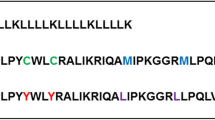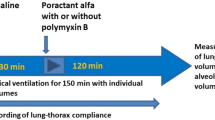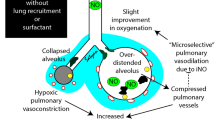Abstract
Studies were conducted to assess the efficacy and safety of a synthetic peptide-containing surfactant in the treatment of respiratory distress syndrome (RDS) in preterm (approximately 80% of normal gestation) infant rhesus monkeys. Surfactant was prepared consisting of the phospholipids dipalmitoylphosphatidyl choline and palmitoyl-oleoyl phosphatidyl glycerol and a synthetic peptide modeled after surfactant protein B (SP-B),“KL4-Surfactant” contained a peptide having the sequence KLLLLKLLLLKLLLLKLLLLK, where “K” is lysine and “L” is leucine. The peptide was selected because it mimics the repeating stretches of hydrophobic residues with intermittent basic hydrophilic residues seen in SP-B. KL4-Surfactant was shown to have biophysical activity assessed as the ability to lower surface tension at an air-liquid interface in a pulsating bubble surfactometer. Thirty premature rhesus monkeys were treated shortly after birth with one dose of KL4-Surfactant. The arterial to alveolar oxygen partial pressure ratio (a/A) was found to rise from a pretreatment level of 0.11 ± 0.01 (mean ± SEM), indicative of severe RDS, to 0.40 ± 0.02 at 12-13 h post-treatment. The improvement in oxygenation persisted throughout the study period, with a mean a/A at 22-23 h of 0.45± 0.07. Chest radiographs and gross and microscopic examination of the lungs all confirmed the reversal of the atelectasis seen before treatment. Animals treated with a dose of 200 mg/kg showed a faster, more consistent, and greater response than did a group treated with an average dose of 127 mg/kg. There was no evidence of toxicity after treatment with the higher dose as demonstrated by physiologic, hematologic, biochemical, and pathologic data. The importance of the peptide in the synthetic surfactant was apparent from the results obtained with a control group of nine premature monkeys treated with a non-peptide-containing surfactant; the a/A of this group was 0.15± 0.03 at nine hours of age as compared with a value of 0.38 ± 0.02 for 30 comparable animals receiving KL4-Surfactant.
Similar content being viewed by others
Log in or create a free account to read this content
Gain free access to this article, as well as selected content from this journal and more on nature.com
or
Abbreviations
- a/A:
-
ratio of arterial to alveolar oxygen tension
- DPPC:
-
dipalmitoyl-sn-glycero-3-phosphocholine
- Fio2:
-
fraction of inspired oxygen
- MAP:
-
mean airway pressure
- PG:
-
phosphatidyl glycerol
- POPG:
-
1-palmitoyl-2-oleoyl-sn-glycero-3-phosphoglycerol
- RDS:
-
respiratory distress syndrome
- SP:
-
surfactant protein
References
Yu S-H, Possmayer F 1988 Comparative studies on the biophysical activities of the low-molecular-weight hydrophobic proteins purified from bovine pulmonary surfactant. Biochim Biophys Acta 961: 337–350.
Revak SD, Merritt TA, Degryse E, Stefani L, Courtney M, Hallman M, Cochrane CG 1988 Use of human surfactant low molecular weight apoprotein in the reconstitution of surfactant biologic activity. J Clin Invest 81: 826–833.
Curstedt T, Jornvall H, Robertson B, Bergman T, Berggren P 1987 The hydrophobic low-molecular mass protein fractions of pulmonary surfactant: characterization and biophysical activity. Eur J Biochem 168: 255–262.
Sarin VK, Gupta S, Leung TK, Taylor VE, Ohning BL, Whitsett JA, Fox JL 1990 Biophysical and biological activity of a synthetic 8.7 kD hydrophobic pulmonary surfactant protein SP-B. Proc Natl Acad Sci USA 87: 2633–2637.
Nogee LM, de Mello DE, Dehner LP, Colten HR 1993 Brief report: deficiency of pulmonary surfactant protein B in congenital alveolar proteinosis. N Engl J Med 328: 406–410.
Fujita Y, Kogishi K, Suzuki Y 1988 Pulmonary damage induced in mice by a monoclonal antibody to proteins associated with pig pulmonary surfactant. Exp Lung Res 14: 247–260.
Kobayashi T, Nitta K, Takahashi R, Kurashima K, Robertson B, Suzuki Y 1991 Activity of pulmonary surfactant after blocking the associated proteins SP-A and SP-B. J Appl Physiol 71: 530–536.
Robertson B, Kobayashi T, Ganzuka M, Grossmann G, Li WZ, Suzuki Y 1991 Experimental neonatal respiratory failure induced by a monoclonal antibody to the hydrophobic surfactant-associated protein SP-B. Pediatr Res 30: 239–243.
Hawgood S, Benson JB, Schilling J, Damm D, Clements JA, White RT 1987 Nucleotide and amino acid sequences of pulmonary surfactant protein SP18. Proc Natl Acad Sci USA 84: 66–70.
Glasser SW, Korfhagen TR, Weaver T, Pilot-Matias T, Fox JL, Whitsett JA 1987 cDNA and deduced amino acid sequence of pulmonary surfactant-associated proteolipid SPL (Phe). Proc Natl Acad Sci USA 84: 4007–4011.
Curstedt T, Johansson J, Barros-Soderling J, Robertson B, Nilsson G, Westberg M, Jornvall H 1988 Low-molecular-mass surfactant protein type 1: the primary structure of a hydrophobic 8-kDa polypeptide with eight half-cystine residues. Eur J Biochem 172: 521–525.
Olafson RW, Rink U, Kielland S, Yu SH, Chung J, Harding PG, Possmayer F 1987 Protein sequence analysis studies on the low molecular weight hydrophobic proteins associated with bovine pulmonary surfactant. Biochem Biophys Res Commun 148: 1406–1411.
Yu S-H, Possmayer F 1986 Reconstitution of surfactant activity by using 6 kDa apoprotein associated with pulmonary surfactant. Biochem J 236: 85–89.
Whitsett JA, Ohning BL, Ross G, Meuth J, Weaver T, Holm BA, Shapiro DL, Notter RH 1986 Hydrophobic surfactant-associated protein in whole lung surfactant and its importance for biophysical activity in lung surfactant extracts used for replacement therapy. Pediatr Res 20: 460–467.
Benson B, Hawgood S, Schilling J, Clements J, Damm D, Cordell B, White RT 1985 Structure of canine pulmonary surfactant apoprotein cDNA and complete amino acid sequence. Proc Natl Acad Sci USA 82: 6379–6383.
Emrie PA, Shannon JM, Mason RJ, Fisher JH 1989 cDNA and deduced amino acid sequence for the rat hydrophobic pulmonary surfactant-associated protein, SP-B. Biochim Biophys Acta 994: 215–221.
Jacobs KA, Phelps DS, Steinbrink R, Fisch J, Kriz R, Mitsock L, Dougherty JP, Taeusch HW, Flores J 1987 Isolation of a cDNA clone encoding a high molecular weight precurser to a 6-kDa pulmonary surfactant-associated protein. J Biol Chem 262: 9808–9811.
Revak SD, Merritt TA, Hallman M, Heldt G, La Polla RJ, Hoey K, Houghten RA, Cochrane CG 1991 The use of synthetic peptides in the formation of biophysically and biologically active pulmonary surfactants. Pediatr Res 29: 460–465.
Waring A, Taeusch W, Bruni R, Amirkhanian J, Fan B, Stevens R, Young J 1989 Synthetic amphipathic sequences of surfactant protein-B mimic several physicochemical and in vivo properties of native pulmonary surfactant proteins. Peptide Res 2: 308–313.
McLean LR, Krstenansky JL, Jackson RL, Hagaman KA, Olsen KF, Lewis JE 1992 Mixtures of synthetic peptides and dipalmitoylphosphatidylcholine as lung surfactants. Am J Physiol 262:L292–L300.
McLean LR, Lewis JE, Krstenansky JL, Hagaman KA, Cope AS, Olsen KF, Matthews ER, Uhrhammer DC, Owen TJ, Payne MH 1993 An Amphipathic -helical decapeptide in phosphatidylcholine is an effective synthetic lung surfactant. Am Rev Respir Dis 147: 462–465.
Cochrane CG, Revak SD 1990 Surfactant protein SP-B. Pediatr Res 27: 297A (abstr)
Cochrane CG, Revak SD 1991 Pulmonary surfactant protein B (SP-B): structure-function relationships. Science 254: 566–568.
Vandenbussche G, Clercx A, Clercx M, Curstedt T, Johansson J, Jornvall H, Ruysschaert JM 1992 Secondary structure and orientation of the surfactant protein SP-B in a lipid environment. A Fourier transform infrared spectroscopy study. Biochemistry 31: 9169–9176.
Vincent JS, Revak SD, Cochrane CG, Levin IW 1991 Raman spectroscopic studies of model human pulmonary surfactant systems: phospholipid interactions with peptide paradigms for the surfactant protein SP-B. Biochemistry 30: 8395–8401.
Baatz JE, Elledge B, Whitsett JA 1990 Surfactant protein SP-B induces ordering at the surface of model membrane bilayers. Biochemistry 29: 6714–6720.
Bruni R, Taeusch HW, Waring AJ 1991 Surfactant protein B: lipid interactions of synthetic peptides representing the amino-terminal amphipathic domain. Proc Natl Acad Sci USA 88: 7451–7455.
Tanaka Y, Takei T, Aiba T, Masuda K, Kiuchi A, Fujiwara T 1986 Development of synthetic lung surfactants. J Lipid Res 27: 475–485.
Cochrane CG, Revak SD, Merritt TA, Heldt GP, Hallman M, Cunningham MD, Easa D, Pramanik A, Edwards DK, Alberts MS 1996 The efficacy and safety of KL4-Surfactant in preterm infants with RDS. Am J Respir Crit Care Med 153: 404–410.
Hallman M, Merritt TA, Schneider H, Epstein BL, Mannino F, Edwards DK, Gluck L 1983 Isolation of human surfactant from amniotic fluid and a pilot study of its efficacy in respiratory distress syndrome. Pediatrics 71: 473–482.
Revak SD, Merritt TA, Hallman M, Cochrane CG 1986 Reconstitution of surfactant activity using purified human apoprotein and phospholipids measured in vitro and in vivo. Am Rev Respir Dis 134: 1258–1265.
Epstein NE, Farrell PM, Chez RA 1976 Fetal lung lecithin metabolism and the amniotic fluid L/S ratio in rhesus monkey gestations. Am J Obstet Gynecol 125: 545–549.
Edwards DK, Hilton SvW, Merritt TA, Hallman M, Mannino F, Boynton F 1985 Respiratory distress syndrome treated with human surfactant: radiographic findings. Radiology 157: 329–334.
Harker LC, Kirkpatrick SE, Friedman WF, Bloor CM 1981 Effects of indomethacin on fetal rat lungs: a possible cause of persistent fetal circulation (PFC). Pediatr Res 15: 147–151.
Goetzman BW, Read LC, Plopper CG, Tarantal AF, George-Nascimento C, Merritt TA, Whitsett JA, Styne D 1994 Prenatal exposure to epidermal growth factor attenuates respiratory distress syndrome in rhesus infants. Pediatr Res 35: 30–36.
Merritt TA, Amirkhanian JD, Helbock H, Halliwell B, Cross CE 1993 Reduction of the surface-tension-lowering ability of surfactant after exposure to hypochlorous acid. Biochem J 295: 19–22.
Amirkhanian JD, Kheiter A, Merritt TA 1994 Comparative Evaluation of Reduction in surface-tension lowering ability of Survanta and KL4-Surfactant by some serum components. Pediatr Res 35: 324A
Merritt TA, Kheiter A, Cochrane C 1995 Positive end expiratory pressure during instillation enhances distribution of exogenous KL4-Surfactant in Simian respiratory distress syndrome. Pediatr Res 38: 211–217.
Acknowledgements
The authors are grateful to Kenway Hoey, Tom Madden, and Pete Glavinos for preparation of synthetic peptides and many of the batches of peptide containing surfactant. We thank Dr. Colin Bloor for the morphometric analyses of lung histologic sections. We also thank Sarah Davis and the staff of the California Regional Primate Research Center in Davis, CA, without whose expert assistance these studies could not have been performed.
Author information
Authors and Affiliations
Additional information
Supported by Grant HL-23584 from the Public Health Service, Grant N00014 from the Office of Naval Research, Primate Research Center Grant National Institutes of Health RR00169, and by the R. W. Johnson Pharmaceutical Research Institute.This is publication number 9057-IMM from the Department of Immunology, The Scripps Research Institute.
Rights and permissions
About this article
Cite this article
Revak, S., Merritt, T., Cochrane, C. et al. Efficacy of Synthetic Peptide-Containing Surfactant in the Treatment of Respiratory Distress Syndrome in Preterm Infant Rhesus Monkeys. Pediatr Res 39, 715–724 (1996). https://doi.org/10.1203/00006450-199604000-00025
Received:
Accepted:
Issue date:
DOI: https://doi.org/10.1203/00006450-199604000-00025
This article is cited by
-
Evolution of surfactant therapy for respiratory distress syndrome: past, present, and future
Pediatric Research (2017)
-
Synthetic surfactants: where are we? Evidence from randomized, controlled clinical trials
Journal of Perinatology (2009)
-
Prognose extrem unreifer Frühgeborener
Monatsschrift Kinderheilkunde (2005)



